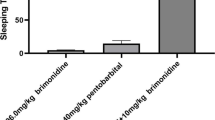Abstract
Of the ultra-short- and short-acting barbiturates thiopentone sodium and pentobarbitone sodium require higher dosages for sugical procedures in the dog, sheep and goat in a temperate climate (Zürich, Munich, Liverpool) than in a tropical climate (Khartoum, Sudan). This also applies to the morphium derivative thiambutene-HCl in the dog. The relationship is reversed for methadone-HCl, for which an up to 50% higher dose was needed in Khartoum and apparently is brought about by a complex physico-chemical mechanism, the dynamics of which require further investigation.
Zusammenfassung
Von den kurz- und mittellang-wirkenden Barbituraten Thiopenton-Na und Pentobarbiton-Na sind für chirurgische Eingriffe in gemässigtem Klima (Zürich, München, Liverpool) bei Hund, Schaf und Ziege höhere Dosierungen erforderlich als in tropischem Klima (Khartoum, Sudan). Dies gilt auch für das Morphium-Derivat Thiambuten-HCl beim Hund. Die Beziehung ist umgekehrt für Methadon-HCl, von dem in Khartoum eine bis um 50% höhere Dosierung benötigt wird, die offenbar auf einem komplexen Mechanismus physikalisch-chemischer Art beruht, dessen Dynamik weiterer Abklärung bedarf.
Resume
L'emploi des barbituriques à courte et moyenne action: le thiopentone-Na et le pentobarbitone-Na pour les interventions chirurgicales sur le chien, le mouton et la chèvre, exige des doses plus fortes en climat tempéré (Zurich, Munich, Liverpool) qu'en climat tropical (Khartoum, Soudan). Chez le chien cela s'applique aussi à l'utilisation du dérivé de la morphine: le thiambutène-HCl. Par contre l'inverse se produit dans le cas du méthadone-HCl, pour lequel des doses jusqu'à 50% supérieures sont nécessaires à Khartoum. Ceci s'explique apparement par un méchanisme d'ordre physico-chimique complexe, dont la dynamique demande à être approfondie.
Similar content being viewed by others
References
FUHRMAN, F.A. (1946): The effect of body temperature on drug action.Physiol.Rev., 26: 247–274.
FUHRMAN, G.J. and FUHRMAN, F.A. (1961): Effects of temperature on the action of drugs. Ann.Rev.Pharm., 1: 65–78.
FUHRMAN, F.A. (1963): Modification of the action of drugs by heat. Arid Zone Research (Unesco), 22: 223–237.
HERR, F., BORSI, I. and PATAKY, G.Y. (1954): Wirkung der Umwelttemperatur auf die Toxicität der Analgetika. Arch.exp.Path.Pharm., 223: 56–63.
RICHARDS, R.K. and TAYLOR, J.D. (1956): Some factors influencing distribution, metabolism and action of barbiturates. A Review. Anesthesiology, 17: 414–458.
SCHÜEPP, M. (1968): Personal communication.
WALTER, H. and LIETH, H. (1967): Klimadiagramm-Weltatlas. Fischer, Jena.
WEILENMANN, P. (1958): Die Presuren-Narkose beim Hund. Thesis, University of Zürich.
WESTHUES, M. and FRITSCH, R. (1961): Die Narkose der Tiere. Bd. II Allgemeinnarkose. Parey, Berlin & Hamburg.
WRIGHT, J.G. and HALL, L.W. (1961): Veterinary Anesthesia and Analgesia. Baillière, Tindall and Cox, London.
Author information
Authors and Affiliations
Rights and permissions
About this article
Cite this article
Krahenmann, J.A. Observations on dosage of drugs for anesthesia of domestic animals in temperate and tropical climate. Int J Biometeorol 13, 257–264 (1969). https://doi.org/10.1007/BF01553033
Received:
Issue Date:
DOI: https://doi.org/10.1007/BF01553033




